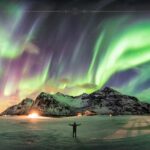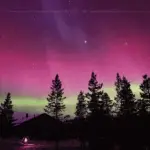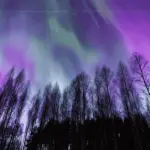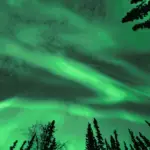The mesmerizing dance of the northern lights may illuminate the night sky this evening, offering a rare opportunity to witness one of nature’s most spectacular phenomena. The National Oceanic and Atmospheric Administration (NOAA) has forecasted favorable conditions for aurora visibility in several northern states, while also warning of potential radio communication disruptions throughout the weekend.
Tonight’s Aurora Forecast
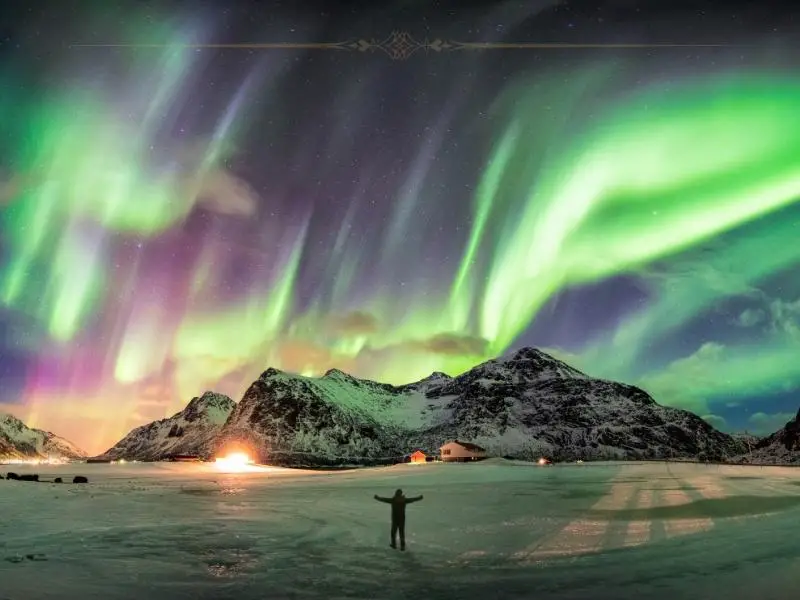
Skywatchers in northern regions have reason for optimism tonight as geomagnetic activity increases to moderate levels. NOAA has issued a forecast with a Kp index of four on the nine-point scale used to measure auroral activity. This elevated reading suggests that the ethereal curtains of light may extend further south than usual, potentially reaching portions of the northern United States.
The anticipated display comes amid the current solar maximum, a period that typically produces more frequent and intense auroral events. While tonight promises the best viewing opportunities, the celestial spectacle is expected to diminish over the weekend, with NOAA predicting lower Kp index values of two and three for Saturday and Sunday nights respectively.
The captivating light displays known as aurora borealis occur through a complex interaction between our planet and the sun. When the sun releases energy and particles through events such as solar flares and coronal mass ejections, these energetic particles travel through space and eventually encounter Earth’s magnetic field.
Upon reaching our planet, these solar particles interact with gases in our upper atmosphere. The collision excites oxygen and nitrogen molecules, causing them to release energy in the form of light. This atmospheric reaction creates the shimmering curtains of green, red, and sometimes purple light that characterize the northern lights.
The solar cycle, which follows an approximately 11-year pattern, reached its maximum in October 2024, according to NASA. During solar maximum, increased solar activity leads to more frequent and powerful geomagnetic storms, enhancing both the intensity and geographic reach of auroral displays.
Prime Viewing Locations
For tonight’s event, NOAA indicates that northern Canada and Alaska remain the regions with the highest probability of witnessing the aurora with the naked eye. However, residents in several U.S. states have varying chances of experiencing this natural wonder.
States with moderate visibility potential include Washington, Montana, North Dakota, and Minnesota, which lie directly along the Canadian border. Slightly further south, there’s a lower but still present chance of auroral activity in Idaho, South Dakota, Wisconsin, Michigan, and Maine.
The further north you are located, the better your chances of witnessing this celestial phenomenon. Locations near the 45th parallel and above typically offer the most consistent viewing opportunities during moderate geomagnetic storms like the one forecasted for tonight.
Weather Considerations for Aurora Viewing
While geomagnetic conditions determine whether an aurora will occur, local weather plays an equally crucial role in whether observers can actually see it. Clear, dark skies are essential for optimal aurora viewing. Unfortunately, cloud cover and precipitation can completely obstruct even the most brilliant displays.
Weather systems moving across the northern United States may impact visibility in certain regions tonight. Residents in areas with potential aurora activity should monitor local weather forecasts alongside the aurora predictions to determine if conditions will permit viewing.
Light pollution also significantly affects aurora visibility. Urban centers with their abundance of artificial light can wash out the relatively subtle glow of even moderate auroral displays. This is why seeking locations away from city lights dramatically improves the chances of witnessing the northern lights in all their glory.
Optimal Viewing Techniques
For those hoping to catch a glimpse of this celestial spectacle, NOAA recommends finding a north-facing, elevated location with minimal light pollution. The prime viewing hours typically fall between 10 p.m. and 2 a.m. local time, when darkness is most complete and auroral activity often peaks.
Patience is essential when aurora hunting. The lights may appear suddenly, and their intensity can fluctuate throughout the night. Allowing your eyes to adjust to the darkness by avoiding phone screens and other light sources will significantly enhance your ability to perceive even faint auroral activity.
Binoculars and telescopes are generally unnecessary for aurora viewing, as the phenomenon covers large portions of the sky. Instead, a comfortable chair, warm clothing, and perhaps a thermos of hot beverage are more practical accessories for the often lengthy and chilly pursuit of the northern lights.
Capturing the Northern Lights
For those hoping to preserve their aurora experience through photography, certain techniques can help capture these elusive lights. Professional photographers recommend using a camera with a wide-angle lens to encompass the expansive nature of the aurora. An aperture setting (F-stop) of four or lower allows maximum light capture, while focusing at infinity ensures the distant lights remain sharp.
A stable tripod is essential due to the longer exposure times needed in low-light conditions. Exposure settings between 5-20 seconds typically work well for northern lights photography, though this varies based on the aurora’s brightness and movement.
Smartphone users need not feel excluded from aurora photography. Modern phone cameras have increasingly capable night modes. NOAA suggests activating this feature while also reducing shutter speed and disabling flash. Additionally, propping the phone against a stable surface or using a phone tripod can significantly improve results by eliminating camera shake during longer exposures.
Solar Activity and Radio Communications
Beyond the visual spectacle, the increased solar activity responsible for the aurora carries other impacts. NOAA has indicated that minor to moderate radio blackouts are possible throughout the weekend. These disruptions primarily affect high-frequency radio communications, which are used in various applications including aviation, maritime operations, and some emergency services.
Radio blackouts occur when radiation from solar flares ionizes Earth’s upper atmosphere, temporarily changing its properties and disrupting radio wave propagation. These effects are most pronounced on the dayside of Earth facing the sun and typically last from minutes to a few hours.
For most individuals, these radio disruptions go unnoticed in daily life. However, they represent one of several space weather phenomena that scientists carefully monitor due to their potential impact on technological systems.
Historical Context and Recent Aurora Events
The current period of heightened solar activity follows a relatively quiet solar cycle that ended in 2019. According to NASA, the present solar maximum, which began in October 2024, is expected to persist into early 2026, providing ample opportunities for aurora viewing over the next year.
Last year witnessed one of the most remarkable aurora events in recent memory when an exceptionally powerful geomagnetic storm pulled the northern lights unusually far south. During this extraordinary event, the aurora was visible as far south as Florida and Texas, locations that almost never experience such displays. This rare occurrence was the strongest geomagnetic storm recorded in two decades.
While tonight’s forecast doesn’t suggest such an extreme southern reach, it does represent the type of moderate geomagnetic activity that makes aurora viewing possible for millions of people who don’t typically have such opportunities.
The Growing Interest in Aurora Tourism
The fascination with the northern lights has fueled a significant tourism industry in countries like Iceland, Norway, and Finland, where aurora viewing is more reliable during winter months. In North America, destinations in Alaska and northern Canada similarly attract thousands of visitors annually specifically for aurora experiences.
The appeal of witnessing this natural phenomenon firsthand has only increased with the proliferation of stunning aurora photography on social media platforms. Many travelers now include aurora viewing on their bucket lists, planning entire vacations around the possibility of witnessing the dancing lights.
For those unable to travel to traditional aurora-viewing destinations, events like tonight’s forecast offer rare opportunities to experience the northern lights closer to home. When moderate or strong aurora displays extend into more populated regions, they often create memorable shared experiences as communities gather to witness the uncommon sight.
Preparing for Future Aurora Opportunities
While tonight presents a promising opportunity for aurora viewing in northern regions, the current solar maximum means increased chances for similar events throughout the coming year. By understanding the patterns and conditions that lead to visible auroras, interested skywatchers can better prepare for future events.
Several resources exist to help track aurora activity. NOAA’s Space Weather Prediction Center provides regularly updated forecasts and maintains a 30-minute aurora forecast tool on their website. Various smartphone applications also offer aurora alerts that notify users when conditions are favorable in their area.
Understanding local factors that affect visibility is equally important. Familiarizing yourself with nearby locations that offer dark skies and unobstructed northern views can save valuable time when an aurora alert arrives. Many experienced aurora watchers maintain a “go bag” with essentials like warm clothing, camera equipment, and snacks, allowing them to quickly capitalize on unexpected viewing opportunities.
Beyond creating the beautiful aurora displays, the current period of heightened solar activity has significant scientific importance. Researchers closely study solar maximum periods to better understand the sun’s behavior and its effects on Earth.
The data collected during these active periods helps refine models of solar physics and improves our ability to predict space weather events. This research has practical applications in protecting satellites, power grids, and other technological infrastructure that can be vulnerable to extreme solar events.
For the general public, however, the most accessible and immediate benefit of the solar maximum remains the increased opportunities to witness one of nature’s most captivating displays. Tonight’s aurora forecast represents just one such opportunity in what promises to be an active period for northern lights enthusiasts.
The Universal Appeal of the Aurora
Few natural phenomena capture human imagination quite like the aurora borealis. Across cultures and throughout history, these dancing lights have inspired myths, folklore, and artistic expression. Indigenous peoples of northern regions incorporated the lights into their cosmologies and spiritual practices, while early scientists sought to understand the physical mechanisms behind the mysterious displays.
Today, despite our scientific understanding of their cause, the northern lights continue to evoke wonder and awe. There remains something profoundly moving about standing beneath a sky transformed by undulating curtains of colored light, a reminder of the dynamic relationship between our planet and the sun.
For those fortunate enough to witness tonight’s potential display, the experience may well become a cherished memory—a moment of connection with one of nature’s most beautiful manifestations and a reminder of our place within a vast and dynamic cosmos.

